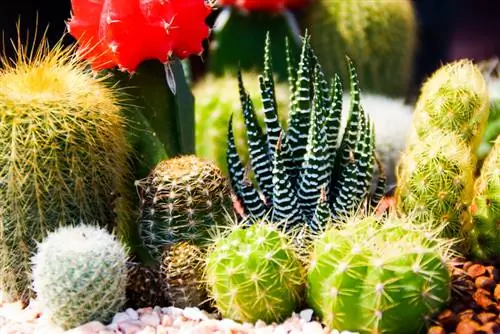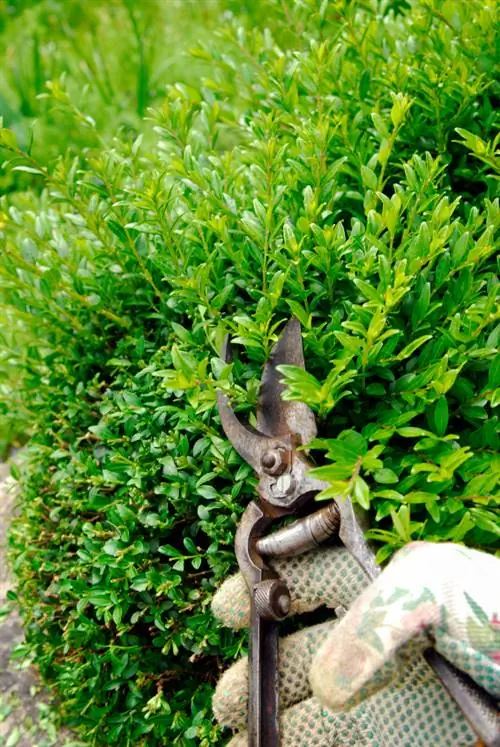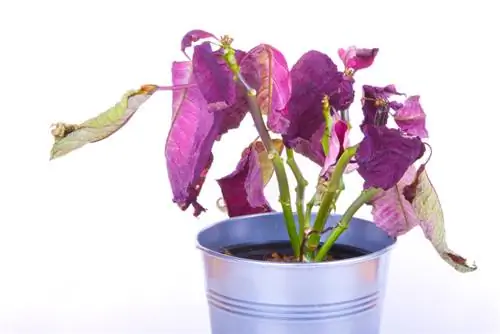- Author admin [email protected].
- Public 2023-12-16 16:46.
- Last modified 2025-06-01 06:02.
Cacti are considered the paragon of frugality and ideal houseplants for beginners. In order for the thorny flower beauties from distant countries to feel at home on the windowsill, species-appropriate care is important. The following answers to important questions provide you with the right care for succulents.

How do you properly care for cacti?
Proper cactus care includes regular watering during the growth phase, nutrient supply with special succulent fertilizer, occasional pruning and adjusting the environment during the winter break. Protect your cacti from diseases and pests by taking appropriate measures.
Watering cacti correctly - how does it work?
As succulents, cacti immediately absorb every drop of water they can get and store up supplies in the trunk or leaves. By watering the plants rarely but thoroughly, you can skilfully tailor the water supply to this specific characteristic. How to do it right:
- Watere from spring to autumn when the top layer of soil has dried out
- Let the lime-free water run onto the substrate until the saucer fills up
- Successively reduce the amount of water from September
In winter, only water your cacti little by little so that the root ball does not dry out completely. This almost dry resting phase makes an important contribution to the formation of buds for the next flower festival.
Do cacti need to be fertilized?
The modest requirements of cacti do not mean that the plants can completely do without additional nutrients. From May to September, please add a liquid fertilizer (€6.00 on Amazon) to the irrigation water. A normal fertilizer for houseplants is unsuitable for this purpose because it contains too much nitrogen. Therefore, use special cactus or succulent fertilizer whose composition is tailored to your specific needs.
Can I cut my cactus?
If a cactus becomes out of shape, becomes too large or has sick, rotten branches, correct the problem by pruning it back. The best time for pruning is between March and May. For soft plant parts, ideally use a disinfected scalpel. A thick or woody epidermis is cut through with a sharp saw knife. Please don't forget to wear sturdy gloves to protect yourself from the thorns.
An oblique cut ensures that no water collects on the cut. Dust the open area lightly with charcoal powder so that it does not bleed too much and heals quickly. So that the cactus can sprout again, please only cut so deeply that at least 2 sleeping eyes remain on the shoot. Buds that can sprout are usually located where thorns or leaves are still sprouting.
How do cacti overwinter intact?
From October to February, cacti stop growing to rest until the next spring. For most cactus species, there are two options for overwintering that require appropriate care:
- Bright to partially shaded and cool at 5 to 10 degrees Celsius
- Do not water or fertilize
- Sunny and warm at normal room temperatures
- Water little by little and do not fertilize
Cacti mostly lay their buds during the winter dormancy. We therefore recommend the bright to partially shaded and cool variant, which proves to be advantageous for lavish flowers. From April/May, the cacti are woken up from hibernation by letting them get used to the sun's rays for 14 days in a partially shaded location and by watering them a little more. Following acclimatization, the normal summer care program begins in a sunny location.
What diseases threaten a cactus?
Regardless of their robust constitution, cacti are not completely immune to disease. Fungal infections such as Fusarium wilt, Phytophthora or Botrytis are at the top of the inglorious list of common cactus diseases. Infected plants have softened, discolored shoots, trunks or roots and can usually no longer be saved.
In the early infestation stage, cut off the infected shoots, leaves or roots and dispose of them with household waste. Immediately repot the cactus into fresh, disinfected substrate and treat it with a fungicide. Please avoid moist, warm cultivation in humus-rich potting soil, as most diseases can be traced back to this.
What pests can attack cacti?
Some pests cannot be prevented from attacking the plants by the thorns on cacti. We have put together the most common parasites with tips on how to combat them here:
- Mealybugs and mealybugs: dab with alcohol-soaked cotton swabs
- Spider mites: shower thoroughly and treat with soft soap solution
- Root lice: unpot, rinse the root ball and treat with neem oil insecticide
- Sad gnats: repot in mineral substrate and keep the dry phase as long as possible
If you have discovered the infamous pests, quarantine the affected cactus immediately. Thanks to this caution, you can effectively prevent spread to neighboring cacti and other houseplants.
Tip
On average, cacti have completely rooted their pot and are repotted every 2 to 3 years. The best time for this care measure is at the end of hibernation. The diameter of the new planter corresponds to around a third of the current height. To ensure that the fresh cactus soil does not carry any pathogens, it is sterilized in the oven at 150 degrees.






